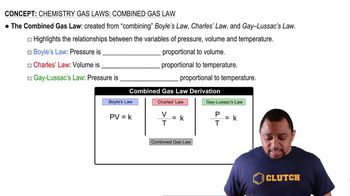Here are the essential concepts you must grasp in order to answer the question correctly.
Stoichiometry
Stoichiometry is the calculation of reactants and products in chemical reactions based on the balanced chemical equation. In this case, the balanced equation shows that one mole of zinc reacts with two moles of hydrochloric acid to produce one mole of hydrogen gas. Understanding stoichiometry allows us to determine the amount of hydrogen gas produced from a given mass of zinc.
Recommended video:
Ideal Gas Law
The Ideal Gas Law relates the pressure, volume, temperature, and number of moles of a gas through the equation PV = nRT. This law is essential for calculating the volume of hydrogen gas produced under specific conditions of pressure and temperature. By rearranging the equation, we can solve for volume when the number of moles of hydrogen is known.
Recommended video:
Gas Laws and Conditions
Gas laws describe the behavior of gases under various conditions. In this problem, we need to consider the pressure (742 mm Hg) and temperature (15 °C) to find the volume of hydrogen gas produced. Converting temperature to Kelvin and pressure to atmospheres may be necessary to apply the Ideal Gas Law correctly, ensuring accurate calculations.
Recommended video:
 Verified step by step guidance
Verified step by step guidance


